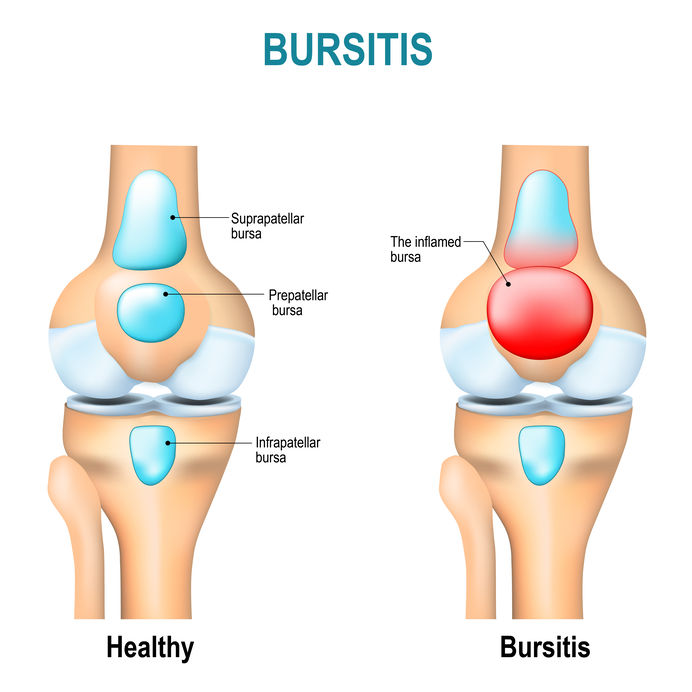 Bursitis is the inflammation of the fluid-filled sac called bursae. The bursae acts as a cushion between the joints, muscles, tendons, and bones and it can cause extreme pain when inflamed. Bursitis is a relatively common condition that affects the joints and can seriously impact your movement if not treated with urgency. The most common locations where bursitis can occur are in the hip, elbow, knee, heel and shoulder. As you can see, this condition mostly appears near joints that experience frequent motion. In this article, we will be looking at everything you need to know about bursitis including the symptoms, causes, and treatment.
Bursitis is the inflammation of the fluid-filled sac called bursae. The bursae acts as a cushion between the joints, muscles, tendons, and bones and it can cause extreme pain when inflamed. Bursitis is a relatively common condition that affects the joints and can seriously impact your movement if not treated with urgency. The most common locations where bursitis can occur are in the hip, elbow, knee, heel and shoulder. As you can see, this condition mostly appears near joints that experience frequent motion. In this article, we will be looking at everything you need to know about bursitis including the symptoms, causes, and treatment.
Symptoms of Bursitis
You will start experiencing pain around the joints and the surrounding areas. This pain builds gradually over time and tends to be severe if calcium deposits are present. Other signs of bursitis could be loss of motion in the shoulder and other joints that encounter frequent motion. The affected joint may look red and swollen, feel stiff or achy and hurts more when you press on it or move it. Acute bursitis usually lasts for some hours or days while chronic bursitis may recur even after treatment. It is important you seek immediate medical attention once you notice any of the above symptoms before they get worse.
What Causes Bursitis?
Wrong posture or repetitive motions that exert extreme pressure on the fluid-filled sacs around a joint cause bursitis. It is also be caused by trauma or injury to the affected area. Although anyone can develop this condition, there are certain factors that increase your risk of bursitis.
Risk Factors of Bursitis
- Age
Bursitis is a common problem with aging, especially on the shoulders. Such people may develop shoulder bursitis and other types of bursitis.
- Athletes
Aggressive movements over time may damage your bursae thus causing bursitis. Direct blows or injuries on the joints might also lead to bursitis.
- Occupation
Certain jobs such as construction or plumbing can increase your chances of bursitis since they regularly put pressure on your joints. For instance, people who work at a construction site can develop bursitis if they lift heavy objects on their shoulder. Plumbers can develop knee bursitis since they put a lot of pressure when fixing or adjusting the plumbing.
- Lifestyle Choices
A sedentary lifestyle is another risk factor that increases your chances of bursitis. It usually occurs as a result of constant pressure applied to the joints when lying or sitting down for prolonged periods at a time.
- Other Medical Conditions
Chronic inflammatory diseases like gout and rheumatoid arthritis are some of the risk factors of bursitis. It can also be caused by certain conditions that compromise your immune system.
What is the Treatment for Bursitis?
The treatment for this condition is determined by the type of bursitis you have. Some of the treatment options include applying an ice pack on the affected area immediately after an injury, taking anti-inflammatory medications and resting the painful or injured area. Your doctor may recommend you to refrain from activities that aggravate the pain so that it can heal properly.
Since chronic bursitis occurs after some time, it is often treated by minimizing the activities that cause the swelling. There are cases where a splint can be used to immobilize the affected extremity. This type of treatment includes knee and elbow padding combined with anti-inflammatory drugs for a few weeks. You may be required to ice the affected area for at least 20 minutes per day until the swelling subsides. If your bursitis was caused by an infection, it needs to be evaluated by your physician to aspirate the bursa. This procedure helps to diagnose an infection and reduce the size of the swelling on the joint.
When to See a Doctor
It is necessary to consult your doctor or physician if you have a sudden inability to move a particular joint or you experience disabling joint pain. You can also seek medical attention when you have a fever, sharp pain, excessive swelling, bruising and redness in the affected area.
Since acute bursitis can become chronic, it is advisable to take necessary steps to prevent this condition from happening. Maintaining a healthy weight and protecting parts of the body that are vulnerable to aggressive movement help prevent bursitis. Strengthening the muscles provide extra protection from injury especially around the joint or where bursitis has occurred. Lastly, it is important to seek immediate medical attention if you notice any pain or discomfort on your joints to prevent the condition from worsening.

